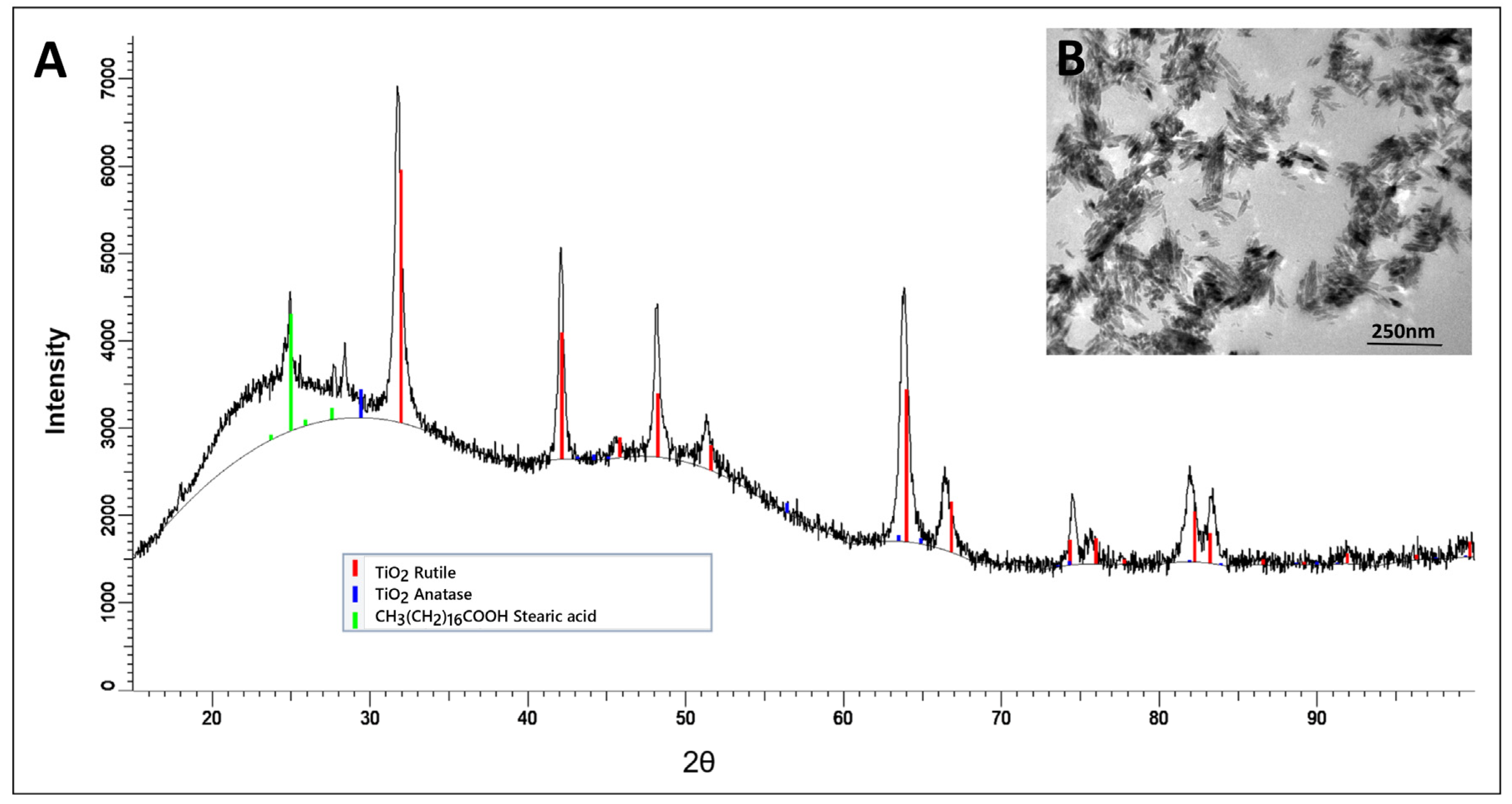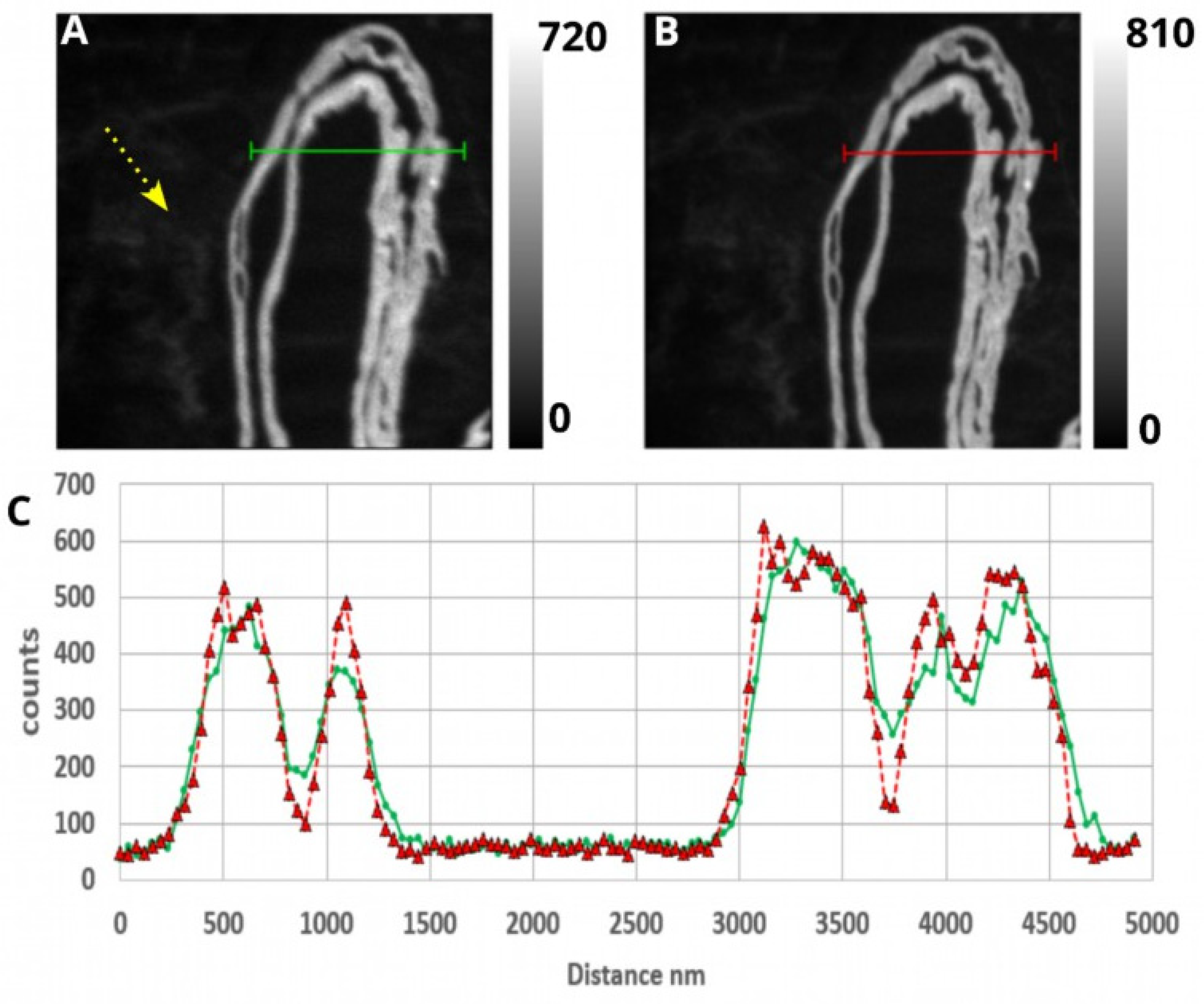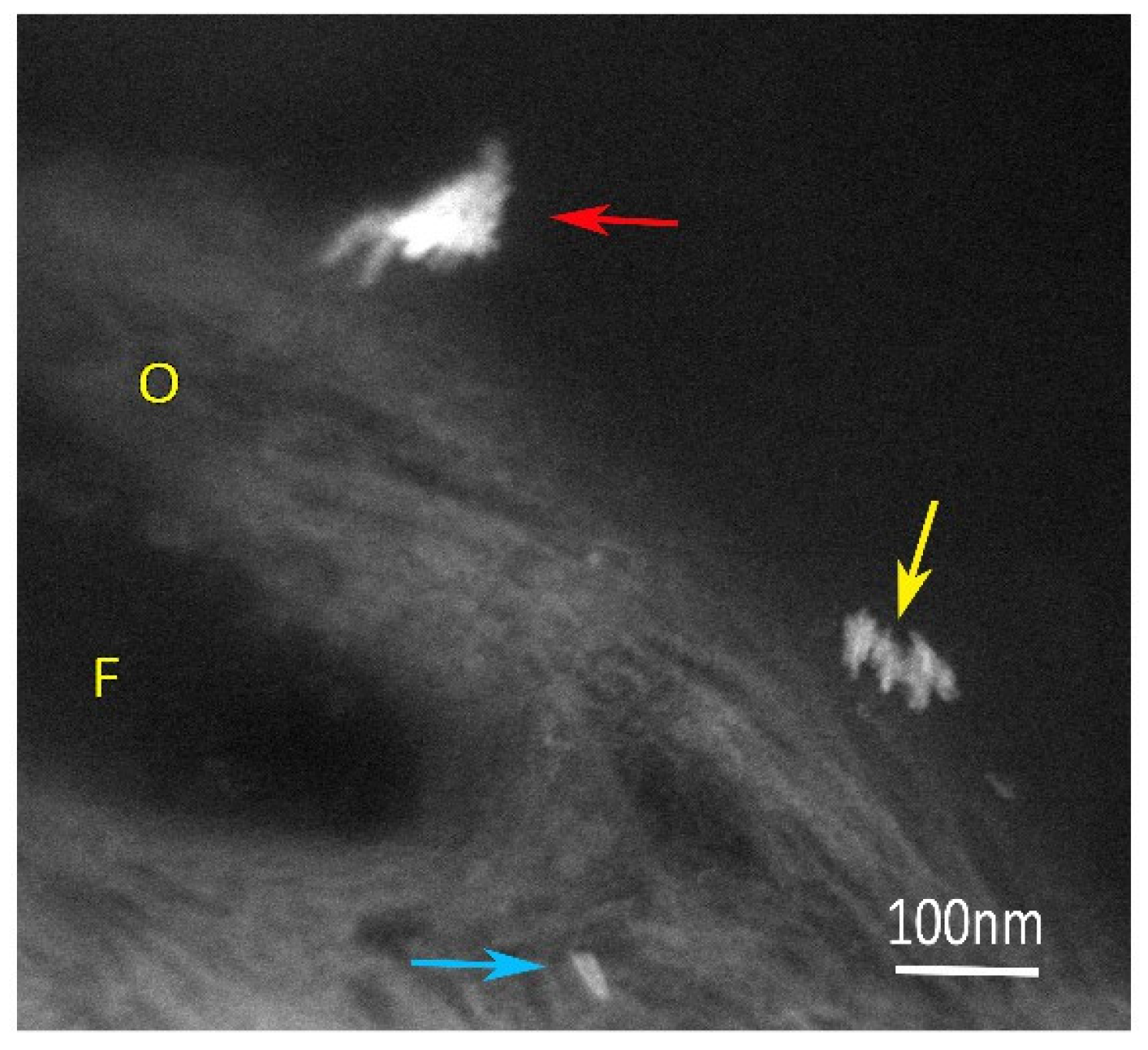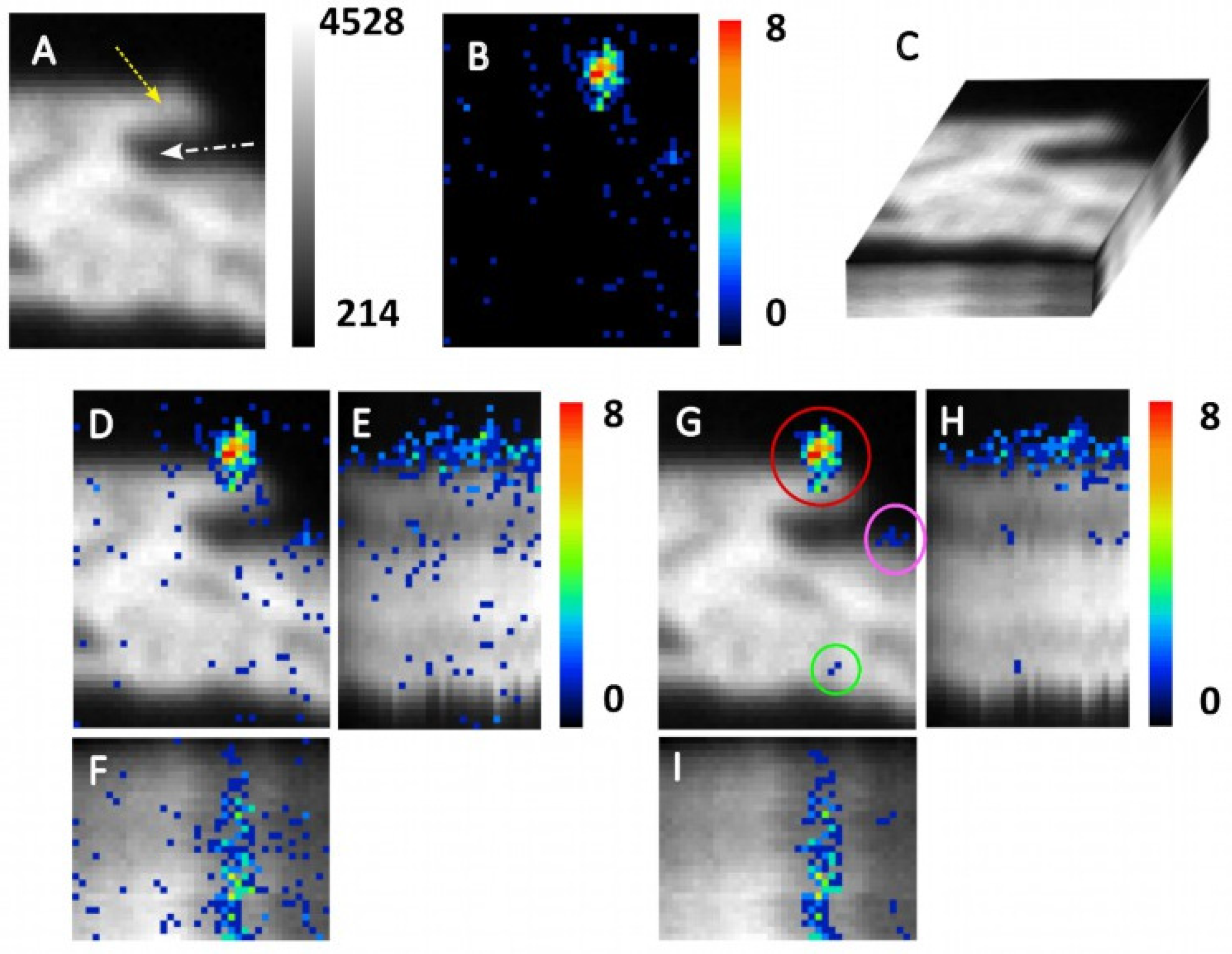The High Resolutive Detection of TiO2 Nanoparticles in Human Corneocytes via TEM/NanoSIMS Correlation
Abstract
1. Introduction
2. Materials and Methods
2.1. Chemicals
2.2. Characterization of TiO2 Nanoparticles
2.3. Skin Sample Preparation
2.4. TEM Analysis
2.5. TEM Image Processing
2.6. SIMS Analyses
2.7. Drift Correction of SIMS Images
2.8. Alignment of TEM and SIMS Images
2.9. Application of the SCP Filter
2.10. 3D Representation
3. Results
3.1. Characterization of the TiO2 NPs in the Sunscreen
3.2. Alignment of SIMS Images
3.3. Alignment of TEM and SIMS Images Using MoDaT
3.4. Localization of Small NP Aggregates
3.5. Toward Isolated NPs’ Detection
3.6. 3D Distribution of NPs
4. Discussion
5. Conclusions
Author Contributions
Funding
Institutional Review Board Statement
Informed Consent Statement
Data Availability Statement
Acknowledgments
Conflicts of Interest
References
- Borm, P.J.; Robbins, D.; Haubold, S.; Kuhlbusch, T.; Fissan, H.; Donaldson, K.; Schins, R.; Stone, V.; Kreyling, W.; Lademann, J.; et al. The potential risks of nanomaterials: A review carried out of ECETOC. Part. Fibre Toxicol. 2006, 3, 11. [Google Scholar] [CrossRef] [PubMed]
- Dréno, B.; Alexis, A.; Chuberre, B.; Marinovich, M. Safety of titanium dioxide nanoparticles in cosmetics. J. Eur. Acad. Dermatol. Venereol. 2019, 33, 34–46. [Google Scholar] [CrossRef] [PubMed]
- Larese Filon, F.; Mauro, M.; Adami, G.; Bovenzi, M.; Crosera, M. Nanoparticles skin absorption: New aspects for a safety profile evaluation. Regul. Toxicol. Pharmacol. 2015, 72, 310–322. [Google Scholar] [CrossRef] [PubMed]
- Crosera, M.; Bovenzi, M.; Maina, G.; Adami, G.; Zanette, C.; Florio, C.; Filon Larese, F. Nanoparticle dermal absorption and toxicity: A review of the literature. Int. Arch. Occup. Environ. Health 2009, 82, 1043–1055. [Google Scholar] [CrossRef] [PubMed]
- Shakeel, M.; Jabeen, F.; Shabbir, S.; Asghar, M.S.; Khan, M.S.; Chaudhry, A.S. Toxicity of Nano-Titanium Dioxide (TiO2-NP) Through Various Routes of Exposure: A Review. Biol. Trace Elem. Res. 2016, 172, 1–36. [Google Scholar] [CrossRef] [PubMed]
- Rossi, S.; Savi, M.; Mazzola, M.; Pinelli, S.; Alinovi, R.; Gennaccaro, L.; Pagliaro, A.; Meraviglia, V.; Galetti, M.; Lozano-Garcia, O.; et al. Subchronic exposure to titanium dioxide nanoparticles modifies cardiac structure and performance in spontaneously hypertensive rats. Part. Fibre Toxicol. 2019, 16, 25. [Google Scholar] [CrossRef] [PubMed]
- Bettini, S.; Boutet-Robinet, E.; Cartier, C.; Coméra, C.; Gaultier, E.; Dupuy, J.; Naud, N.; Taché, S.; Grysan, P.; Reguer, S.; et al. Food-grade TiO2 impairs intestinal and systemic immune homeostasis, initiates preneoplastic lesions and promotes aberrant crypt development in the rat colon. Sci. Rep. 2017, 7, 40373. [Google Scholar] [CrossRef]
- Guillard, A.; Gaultier, E.; Cartier, C.; Devoille, L.; Noireaux, J.; Chevalier, L.; Morin, M.; Grandin, F.; Lacroix, M.Z.; Coméra, C.; et al. Basal Ti level in the human placenta and meconium and evidence of a materno-foetal transfer of food-grade TiO2 nanoparticles in an ex vivo placental perfusion model. Part. Fibre Toxicol. 2020, 17, 51. [Google Scholar] [CrossRef]
- Schulz, J.; Hohenberg, H.; Pflücker, F.; Gärtner, E.; Will, T.; Pfeiffer, S.; Wepf, R.; Wendel, V.; Gers-Barlag, H.; Wittern, K.P. Distribution of sunscreens on skin. Adv. Drug Deliv. Rev. 2002, 54, S157–S163. [Google Scholar] [CrossRef]
- Gontier, E.; Ynsa, M.-D.; Bíró, T.; Hunyadi, J.; Kiss, B.; Gáspár, K.; Pinheiro, T.; Silva, J.-N.; Filipe, P.; Stachura, J.; et al. Is there penetration of titania nanoparticles in sunscreens through skin? A comparative electron and ion microscopy study. Nanotoxicology 2008, 2, 218–231. [Google Scholar] [CrossRef]
- Filipe, P.; Silva, J.N.; Silva, R.; Cirne De Castro, J.L.; Marques Gomes, M.; Alves, L.C.; Santus, R.; Pinheiro, T. Stratum Corneum Is an Effective Barrier to TiO2 and ZnO Nanoparticle Percutaneous Absorption. Skin Pharmacol. Physiol. 2009, 22, 266–275. [Google Scholar] [CrossRef] [PubMed]
- Mavon, A.; Miquel, C.; Lejeune, O.; Payre, B.; Moretto, P. In vitro Percutaneous Absorption and in vivo Stratum Corneum Distribution of an Organic and a Mineral Sunscreen. Skin Pharmacol. Physiol. 2007, 20, 10–20. [Google Scholar] [CrossRef] [PubMed]
- Lekki, J.; Stachura, Z.; Dąbroś, W.; Stachura, J.; Menzel, F.; Reinert, T.; Butz, T.; Pallon, J.; Gontier, E.; Ynsa, M.D.; et al. On the follicular pathway of percutaneous uptake of nanoparticles: Ion microscopy and autoradiography studies. Nucl. Instrum. Methods Phys. Res. Sect. B Beam Interact. Mater. At. 2007, 260, 174–177. [Google Scholar] [CrossRef]
- Pflücker, F.; Hohenberg, H.; Hölzle, E.; Will, T.; Pfeiffer, S.; Wepf, R.; Diembeck, W.; Wenck, H.; Gers-Barlag, H. The Outermost Stratum Corneum Layer is an Effective Barrier Against Dermal Uptake of Topically Applied Micronized Titanium Dioxide. Int. J. Cosmet. Sci. 1999, 21, 399–411. [Google Scholar] [CrossRef] [PubMed]
- Menzel, F.; Reinert, T.; Vogt, J.; Butz, T. Investigations of percutaneous uptake of ultrafine TiO2 particles at the high energy ion nanoprobe LIPSION. Nucl. Instrum. Methods Phys. Res. Sect. B Beam Interact. Mater. At. 2004, 219–220, 82–86. [Google Scholar] [CrossRef]
- Monteiro-Riviere, N.A.; Wiench, K.; Landsiedel, R.; Schulte, S.; Inman, A.O.; Riviere, J.E. Safety Evaluation of Sunscreen Formulations Containing Titanium Dioxide and Zinc Oxide Nanoparticles in UVB Sunburned Skin: An In Vitro and In Vivo Study. Toxicol. Sci. 2011, 123, 264–280. [Google Scholar] [CrossRef] [PubMed]
- Pinheiro, T.; Pallon, J.; Alves, L.C.; Veríssimo, A.; Filipe, P.; Silva, J.N.; Silva, R. The influence of corneocyte structure on the interpretation of permeation profiles of nanoparticles across skin. Nucl. Instrum. Methods Phys. Res. Sect. B Beam Interact. Mater. At. 2007, 260, 119–123. [Google Scholar] [CrossRef]
- Franken, A.; Eloff, F.C.; Du Plessis, J.; Du Plessis, J.L. In Vitro Permeation of Metals through Human Skin: A Review and Recommendations. Chem. Res. Toxicol. 2015, 28, 2237–2249. [Google Scholar] [CrossRef]
- Larese, F.F.; D’Agostin, F.; Crosera, M.; Adami, G.; Renzi, N.; Bovenzi, M.; Maina, G. Human skin penetration of silver nanoparticles through intact and damaged skin. Toxicology 2009, 255, 33–37. [Google Scholar] [CrossRef]
- Wu, J.; Liu, W.; Xue, C.; Zhou, S.; Lan, F.; Bi, L.; Xu, H.; Yang, X.; Zeng, F.D. Toxicity and penetration of TiO2 nanoparticles in hairless mice and porcine skin after subchronic dermal exposure. Toxicol. Lett. 2009, 191, 1–8. [Google Scholar] [CrossRef]
- Belade, E.; Armand, L.; Martinon, L.; Kheuang, L.; Fleury-Feith, J.; Baeza-Squiban, A.; Lanone, S.; Billon-Galland, M.A.; Pairon, J.C.; Boczkowski, J. A comparative transmission electron microscopy study of titanium dioxide and carbon black nanoparticles uptake in human lung epithelial and fibroblast cell lines. Toxicol. In Vitro 2012, 26, 57–66. [Google Scholar] [CrossRef] [PubMed]
- Sadrieh, N.; Wokovich, A.M.; Gopee, N.V.; Zheng, J.; Haines, D.; Parmiter, D.; Siitonen, P.H.; Cozart, C.R.; Patri, A.K.; McNeil, S.E.; et al. Lack of Significant Dermal Penetration of Titanium Dioxide from Sunscreen Formulations Containing Nano- and Submicron-Size TiO2 Particles. Toxicol. Sci. 2010, 115, 156–166. [Google Scholar] [CrossRef] [PubMed]
- Grélard, F.; Legland, D.; Fanuel, M.; Arnaud, B.; Foucat, L.; Rogniaux, H. Esmraldi: Efficient methods for the fusion of mass spectrometry and magnetic resonance images. BMC Bioinform. 2021, 22, 56. [Google Scholar] [CrossRef] [PubMed]
- Leite-Silva, V.R.; Lamer, M.L.; Sanchez, W.Y.; Liu, D.C.; Sanchez, W.H.; Morrow, I.; Martin, D.; Silva, H.D.; Prow, T.W.; Grice, J.E.; et al. The effect of formulation on the penetration of coated and uncoated zinc oxide nanoparticles into the viable epidermis of human skin in vivo. Eur. J. Pharm. Biopharm. 2013, 84, 297–308. [Google Scholar] [CrossRef] [PubMed]
- Saka, S.K.; Vogts, A.; Kröhnert, K.; Hillion, F.; Rizzoli, S.O.; Wessels, J.T. Correlated optical and isotopic nanoscopy. Nat. Commun. 2014, 5, 3664. [Google Scholar] [CrossRef] [PubMed]
- Wilke, K.; Wick, K.; Keil, F.J.; Wittern, K.P.; Wepf, R.; Biel, S.S. A strategy for correlative microscopy of large skin samples: Towards a holistic view of axillary skin complexity. Exp. Dermatol. 2007, 17, 73–80. [Google Scholar] [CrossRef] [PubMed]
- Quintana, C.; Wu, T.D.; Delatour, B.; Dhenain, M.; Guerquin-Kern, J.L.; Croisy, A. Morphological and chemical studies of pathological human and mice brain at the subcellular level: Correlation between light, electron, and nanosims microscopies. Microsc. Res. Tech. 2007, 70, 281–295. [Google Scholar] [CrossRef]
- Vollnhals, F.; Audinot, J.N.; Wirtz, T.; Mercier-Bonin, M.; Fourquaux, I.; Schroeppel, B.; Kraushaar, U.; Lev-Ram, V.; Ellisman, M.H.; Eswara, S. Correlative Microscopy Combining Secondary Ion Mass Spectrometry and Electron Microscopy: Comparison of Intensity–Hue–Saturation and Laplacian Pyramid Methods for Image Fusion. Anal. Chem. 2017, 89, 10702–10710. [Google Scholar] [CrossRef]
- Yedra, L.; Shyam Kumar, C.N.; Pshenova, A.; Lentzen, E.; Philipp, P.; Wirtz, T.; Eswara, W. A correlative method to quantitatively image trace concentrations of elements by combined SIMS-EDX analysis. J. Anal. At. Spectrom. 2021, 36, 56–63. [Google Scholar] [CrossRef]
- Kopp, C.; Domart-Coulon, I.; Escrig, S.; Humbel, B.M.; Hignette, M.; Meibom, A. Subcellular Investigation of Photosynthesis-Driven Carbon Assimilation in the Symbiotic Reef Coral Pocillopora damicornis. mBio 2015, 6, e02299-14. [Google Scholar] [CrossRef]
- LeKieffre, C.; Jauffrais, T.; Geslin, E.; Jesus, B.; Bernhard, J.M.; Giovani, M.E.; Meibom, A. Inorganic carbon and nitrogen assimilation in cellular compartments of a benthic kleptoplastic foraminifer. Sci. Rep. 2018, 8, 10140. [Google Scholar] [CrossRef] [PubMed]
- Nomaki, H.; Bernhard, J.M.; Ishida, A.; Tsuchiya, M.; Uematsu, K.; Tame, A.; Kitahashi, T.; Takahata, N.; Sano, Y.; Toyofuku, T. Intracellular Isotope Localization in Ammonia sp. (Foraminifera) of Oxygen-Depleted Environments: Results of Nitrate and Sulfate Labeling Experiments. Front. Microbiol. 2016, 7, 163. [Google Scholar] [CrossRef] [PubMed]
- Rabasco, S.; Nguyen, T.D.K.; Gu, C.; Kurczy, M.E.; Phan, N.T.N.; Ewing, A.G. Localization and Absolute Quantification of Dopamine in Discrete Intravesicular Compartments Using NanoSIMS Imaging. Int. J. Mol. Sci. 2021, 23, 160. [Google Scholar] [CrossRef] [PubMed]
- Takado, Y.; Knott, G.; Humbel, B.M.; Escrig, S.; Masoodi, M.; Meibom, A.; Comment, A. Imaging liver and brain glycogen metabolism at the nanometer scale. Nanomed. Nanotechnol. Biol. Med. 2015, 11, 239–245. [Google Scholar] [CrossRef] [PubMed]
- Tarolli, J.G.; Jackson, L.M.; Winograd, N. Improving Secondary Ion Mass Spectrometry Image Quality with Image Fusion. J. Am. Soc. Mass Spectrom. 2014, 25, 2154–2162. [Google Scholar] [CrossRef] [PubMed]
- Volland, J.M.; Schintlmeister, A.; Zambalos, H.; Reipert, S.; Mozetič, P.; Espada-Hinojosa, S.; Turk, V.; Wagner, M.; Bright, M. NanoSIMS and tissue autoradiography reveal symbiont carbon fixation and organic carbon transfer to giant ciliate host. ISME J. 2018, 12, 714–727. [Google Scholar] [CrossRef] [PubMed]
- Lange, F.; Agüi-Gonzalez, P.; Riedel, D.; Phan, N.T.N.; Jakobs, S.; Rizzoli, S.O. Correlative fluorescence microscopy, transmission electron microscopy and secondary ion mass spectrometry (CLEM-SIMS) for cellular imaging. PLoS ONE 2021, 16, e0240768. [Google Scholar] [CrossRef] [PubMed]
- Loussert-Fonta, C.; Toullec, G.; Paraecattil, A.A.; Jeangros, Q.; Krueger, T.; Escrig, S.; Meibom, A. Correlation of fluorescence microscopy, electron microscopy, and NanoSIMS stable isotope imaging on a single tissue section. Commun. Biol. 2020, 3, 362. [Google Scholar] [CrossRef]
- Pirozzi, N.M.; Hoogenboom, J.P.; Giepmans, B.N.G. ColorEM: Analytical electron microscopy for element-guided identification and imaging of the building blocks of life. Histochem. Cell Biol. 2018, 150, 509–520. [Google Scholar] [CrossRef]
- Pallon, J.; Garmer, M.; Auzelyte, V.; Elfman, M.; Kristiansson, P.; Malmqvist, K.; Nilsson, C.; Shariff, A.; Wegdén, M. Optimization of PIXE-sensitivity for detection of Ti in thin human skin sections. Nucl. Instrum. Methods Phys. Res. Sect. B Beam Interact. Mater. At. 2005, 231, 274–279. [Google Scholar] [CrossRef]
- Kertész, Z.S.; Szikszai, Z.; Gontier, E.; Moretto, P.; Surlève-Bazeille, J.E.; Kiss, B.; Juhász, I.; Hunyadi, J.; Kiss, A.Z. Nuclear microprobe study of TiO2-penetration in the epidermis of human skin xenografts. Nucl. Instrum. Methods Phys. Res. Sect. B Beam Interact. Mater. At. 2005, 231, 280–285. [Google Scholar] [CrossRef]
- Le Trequesser, Q.; Saez, G.; Simon, M.; Devès, G.; Daudin, L.; Barberet, P.; Michelet, C.; Delville, M.-H.; Seznec, H. Multimodal correlative microscopy for in situ detection and quantification of chemical elements in biological specimens. Applications to nanotoxicology. J. Chem. Biol. 2015, 8, 159–167. [Google Scholar] [CrossRef]
- De Castro, O.; Biesemeier, A.; Serralta, E.; Bouton, O.; Barrahma, R.; Hoang, Q.H.; Cambier, S.; Taubitz, T.; Klingner, N.; Hlawacek, G.; et al. npSCOPE: A New Multimodal Instrument for In Situ Correlative Analysis of Nanoparticles. Anal. Chem. 2021, 93, 14417–14424. [Google Scholar] [CrossRef] [PubMed]
- Vignard, J.; Pettes-Duler, A.; Gaultier, E.; Cartier, C.; Weingarten, L.; Biesemeier, A.; Taubitz, T.; Pinton, P.; Bebeacua, C.; Devoille, L.; et al. Food-grade titanium dioxide translocates across the oral mucosa in pigs and induces genotoxicity in an in vitro model of human oral epithelium. Nanotoxicology 2023, 17, 289–309. [Google Scholar] [CrossRef] [PubMed]
- Dowsett, D.; Wirtz, T. Co-Registered In Situ Secondary Electron and Mass Spectral Imaging on the Helium Ion Microscope Demonstrated Using Lithium Titanate and Magnesium Oxide Nanoparticles. Anal. Chem. 2017, 89, 8957–8965. [Google Scholar] [CrossRef] [PubMed]
- Singh, S.; Singh, H.; Bueno, G.; Deniz, O.; Singh, S.; Monga, H.; Hrisheekesha, P.N.; Pedraza, A. A review of image fusion: Methods, application and performance metrics. Digit. Signal Process. 2023, 137, 104020. [Google Scholar] [CrossRef]
- Delaune, A.; Cabin-Flaman, A.; Legent, G.; Gibouin, D.; Smet-Nocca, C.; Lefebvre, F.; Benecke, A.; Vasse, M.; Ripoll, C. 50 nm-scale localization of single unmodified, isotopically enriched, proteins in cells. PLoS ONE 2013, 8, e56559. [Google Scholar] [CrossRef] [PubMed]
- Ziegler, J.F.; Ziegler, M.D.; Biersack, J.P. SRIM—The stopping and range of ions in matter (2010). Nucl. Instrum. Methods Phys. Res. Sect. B Beam Interact. Mater. At. 2010, 268, 1818–1823. [Google Scholar] [CrossRef]
- Biesemeier, A.; Eibl, O.; Eswara, S.; Audinot, J.N.; Wirtz, T.; Schraermeyer, U. Transition metals and trace elements in the retinal pigment epithelium and choroid: Correlative ultrastructural and chemical analysis by analytical electron microscopy and nano-secondary ion mass spectrometry. Metallomics 2018, 10, 296–308. [Google Scholar] [CrossRef]
- McMahon, G.; Glassner, B.J.; Lechene, C.P. Quantitative imaging of cells with multi-isotope imaging mass spectrometry (MIMS)—Nanoautography with stable isotope tracers. Appl. Surf. Sci. 2006, 252, 6895–6906. [Google Scholar] [CrossRef]
- Audinot, J.; Georgantzopoulou, A.; Piret, J.; Gutleb, A.C.; Dowsett, D.; Migeon, H.N.; Hoffmann, L. Identification and localization of nanoparticles in tissues by mass spectrometry. Surf. Interface Anal. 2013, 45, 230–233. [Google Scholar] [CrossRef]
- Song, G.; Han, J.; Zhao, Y.; Wang, Z.; Du, H. A Review on Medical Image Registration as an Optimization Problem. Curr. Med. Imaging Rev. 2017, 13, 274–283. [Google Scholar] [CrossRef] [PubMed]
- Paul-Gilloteaux, P.; Heiligenstein, X.; Belle, M.; Domart, M.C.; Larijani, B.; Collinson, L.; Raposo, G.; Salamero, J. eC-CLEM: Flexible multidimensional registration software for correlative microscopies. Nat. Methods 2017, 14, 102–103. [Google Scholar] [CrossRef] [PubMed]
- Fernandez, R.; Moisy, C. Fijiyama: A registration tool for 3D multimodal time-lapse imaging. Bioinformatics 2021, 37, 1482–1484. [Google Scholar] [CrossRef] [PubMed]
- Gardés, E.; Gibouin, D.; Radiguet, B.; David, A.; Prellier, W.; Marquardt, K. Magnesium transport in olivine mantle: New insights from miniaturized study of volume and grain boundary diffusion in Mg2SiO4 bi-crystals. Contrib. Mineral. Petrol. 2021, 176, 99. [Google Scholar] [CrossRef]
- Lin, Y.; Hao, J.; Miao, Z.; Zhang, J.; Yang, W. NanoSIMS image enhancement by reducing random noise using low-rank method. Surf. Interface Anal. 2020, 52, 240–248. [Google Scholar] [CrossRef]
- Nikolov, S.G.; Hutter, H.; Grasserbauer, M. De-noising of SIMS images via wavelet shrinkage. Chemom. Intell. Lab. Syst. 1996, 34, 263–273. [Google Scholar] [CrossRef]
- Azari, F.; Vali, H.; Guerquin-Kern, J.L.; Wu, T.D.; Croisy, A.; Sears, S.K.; Tabrizian, M.; McKee, M.D. Intracellular precipitation of hydroxyapatite mineral and implications for pathologic calcification. J. Struct. Biol. 2008, 162, 468–479. [Google Scholar] [CrossRef]
- Clode, P.L.; Kilburn, M.R.; Jones, D.L.; Stockdale, E.A.; Cliff, J.B.; Herrmann, A.M.; Murphy, D.V. In Situ Mapping of Nutrient Uptake in the Rhizosphere Using Nanoscale Secondary Ion Mass Spectrometry. Plant Physiol. 2009, 151, 1751–1757. [Google Scholar] [CrossRef]






Disclaimer/Publisher’s Note: The statements, opinions and data contained in all publications are solely those of the individual author(s) and contributor(s) and not of MDPI and/or the editor(s). MDPI and/or the editor(s) disclaim responsibility for any injury to people or property resulting from any ideas, methods, instructions or products referred to in the content. |
© 2023 by the authors. Licensee MDPI, Basel, Switzerland. This article is an open access article distributed under the terms and conditions of the Creative Commons Attribution (CC BY) license (https://creativecommons.org/licenses/by/4.0/).
Share and Cite
Janin, M.; Delaune, A.; Gibouin, D.; Delaroche, F.; Klaes, B.; Etienne, A.; Cabin-Flaman, A. The High Resolutive Detection of TiO2 Nanoparticles in Human Corneocytes via TEM/NanoSIMS Correlation. Appl. Sci. 2023, 13, 12189. https://doi.org/10.3390/app132212189
Janin M, Delaune A, Gibouin D, Delaroche F, Klaes B, Etienne A, Cabin-Flaman A. The High Resolutive Detection of TiO2 Nanoparticles in Human Corneocytes via TEM/NanoSIMS Correlation. Applied Sciences. 2023; 13(22):12189. https://doi.org/10.3390/app132212189
Chicago/Turabian StyleJanin, Morgane, Anthony Delaune, David Gibouin, Fabien Delaroche, Benjamin Klaes, Auriane Etienne, and Armelle Cabin-Flaman. 2023. "The High Resolutive Detection of TiO2 Nanoparticles in Human Corneocytes via TEM/NanoSIMS Correlation" Applied Sciences 13, no. 22: 12189. https://doi.org/10.3390/app132212189
APA StyleJanin, M., Delaune, A., Gibouin, D., Delaroche, F., Klaes, B., Etienne, A., & Cabin-Flaman, A. (2023). The High Resolutive Detection of TiO2 Nanoparticles in Human Corneocytes via TEM/NanoSIMS Correlation. Applied Sciences, 13(22), 12189. https://doi.org/10.3390/app132212189





